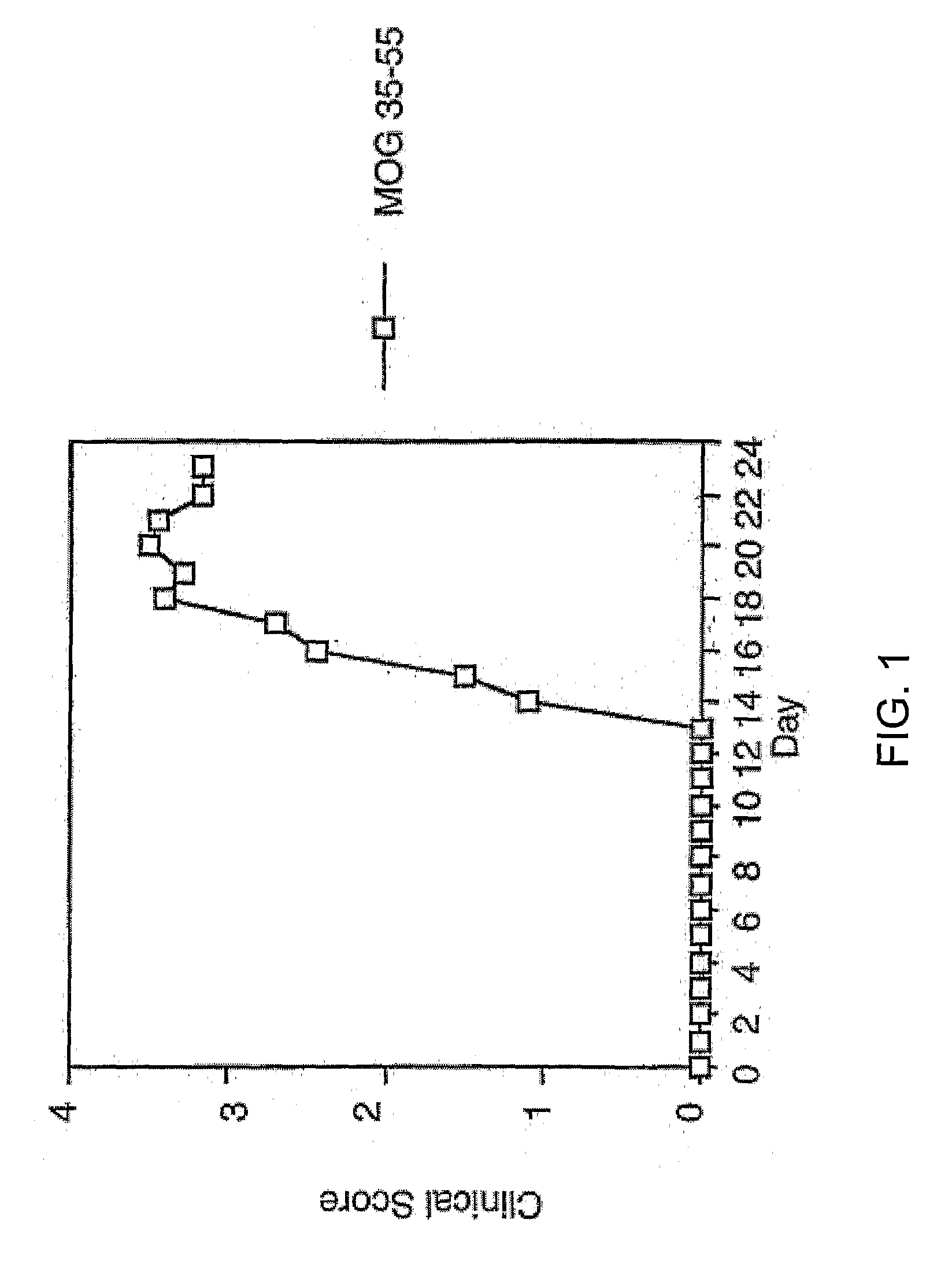Immune response suppressor and treatment of multiple sclerosis
a technology of immune response suppressor and multiple sclerosis, applied in the field of immunology, can solve the problems of insufficient methods of using soluble immune response suppressor or n-terminal peptide, and achieve the effects of increasing the level of at least one anti-inflammatory cytokine, and increasing the level of an immunosuppressive cytokin
- Summary
- Abstract
- Description
- Claims
- Application Information
AI Technical Summary
Benefits of technology
Problems solved by technology
Method used
Image
Examples
example 1
Myelin Oligodendrocyte Glycoprotein Peptide 35-55 Induces Robust Acute EAE in B6 Mice
[0098] Twenty 6-8 week old female C57 / BL6 mice (Jackson Labs, Bar Harbor, Me.) were actively immunized on days 0 and 7 by subcutaneous injection (s.c.) with 0.2 ml inoculum containing 200 mg myelin oligodendrocyte glycoprotein peptide 35-55 [Met Glu Val Gly Trp Tyr Arg Ser Pro Phe Ser Arg Val Val His Leu Tyr Arg Asn Gly Lys, (SEQ ID NO: 2)] in IFA (Difco Labs, Detroit, Mich.) and 800 mg Mycobacterium tuberculosis hominis H35Ra. Pertussis toxin (200 ng) was injected i.p. on days 0 and 2.
[0099] Clinical severity of the initial attack was graded daily as follows by a blinded observer. 0=no disease; 1=minimal or mild hind limb weakness (associated with limp tail); 2=moderate hind limb weakness or mild ataxia (waddling gait and / or poor righting ability); 3=moderate to severe hind limb weakness; 4=severe hind limb weakness or moderate ataxia; 5=paraplegia with no more than moderate four limb weakness; ...
example 2
Parenteral Soluble Immune Response Suppressor Peptide 1-21 Inhibits Acute EAE in B6 Mice
[0100] B6 mice were immunized with myelin oligodendrocyte glycoprotein peptide 35-55 on day 0 as described above. On day −7 preceding active immunization, and continuing through day 14 post immunization, B6 mice (n=8 / group) were injected with 0.1 ml of control saline, 0.1, 1, or 10 mg soluble immune response suppressor peptide 1-21 [Met-Thr-Glu-Glu-Asn-Gln-Gln-Ser-Ser-Gln-Pro-Lys-Thr-Thr-Ile-Asn-Asn-Ala-Gly-Asp-Ser, (SEQ ID. NO: 1)]. FIG. 2 shows that 0.1 and 1 mg soluble immune response suppressor peptide had no significant inhibition of EAE compared to placebo. However, 10 mg of soluble immune response suppressor peptide 1-21 showed a significant inhibition of disease severity compared to placebo, 0.1 and 1 mg dosing (ρ<0.001). Soluble immune response suppressor peptide 10 mg s.c. showed a dose-response effect with doses <10 mg not showing a clinically significant effect.
example 3
Adoptive Transfer of Lymphocytes from Soluble Immune Response Suppressor Peptide-Injected Donors Protects Against EAE in B6 Recipients
[0101] B6 mice effector donors were actively immunized with myelin oligodendrocyte glycoprotein peptide 35-55 described above (day 0) and injected (day −7 through day +14 post-immunization) with 0.1 ml of control saline (n=8) or 10 mg of soluble immune response suppressor peptide 1-21 (n=8). On day 14 post inoculation, splenocytes from both saline-injected (mock control) and soluble immune response suppressor peptide-injected (active treatment) immunized donor mice were re-stimulated in vitro with 30 mg / ml myelin oligodendrocyte glycoprotein peptide 35-55 at 20×106 splenocytes for >1 hour and then diluted to 2-4 million cells / ml and cultured for 48-72 hours in RPMi with 10% FCS and 1% Pen / Strep. Myelin oligodendrocyte glycoprotein-restimulated cells were washed, counted and passively transferred (10×106) i.p. into 8-10 week old female B6 recipients....
PUM
| Property | Measurement | Unit |
|---|---|---|
| Immunogenicity | aaaaa | aaaaa |
Abstract
Description
Claims
Application Information
 Login to View More
Login to View More - R&D
- Intellectual Property
- Life Sciences
- Materials
- Tech Scout
- Unparalleled Data Quality
- Higher Quality Content
- 60% Fewer Hallucinations
Browse by: Latest US Patents, China's latest patents, Technical Efficacy Thesaurus, Application Domain, Technology Topic, Popular Technical Reports.
© 2025 PatSnap. All rights reserved.Legal|Privacy policy|Modern Slavery Act Transparency Statement|Sitemap|About US| Contact US: help@patsnap.com



